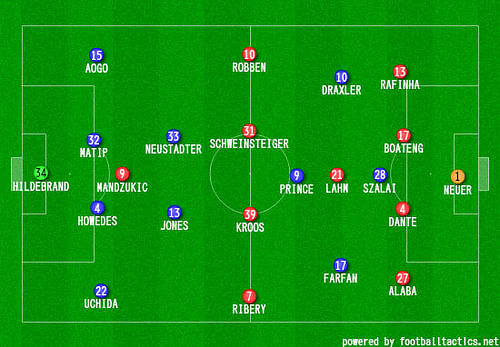
Schalke 0-4 Bayern Munich: Tactical Analysis

Bastian Schweinsteiger celebrates after scoring during the match between Schalke 04 vs Bayern Munich on September 21, 2013. (Getty Images)
There is certainly no love lost Schalke and Bayern Munich; just ask Manuel Neuer.
Both sides were heading into the game off the back of comfortable wins in the Champions League group stage. After Borussia Dortmund had dropped points against Nurnberg early in the day, Bayern Munich had the opportunity to cut the three point deficit at the top.
On the other hand, Schalke have endured a disappointing start to the campaign and were hoping to beat their rivals and give their league campaign a much needed boost.
In terms of personnel, Schalke made just one change to the team that beat Steaua Bucaresti in mid-week, with Jermaine Jones replacing Marco Hoger in the heart of midfield. Likewise Bayern made a single change with Bastian Schweinsteiger replacing Thomas Muller in the starting line-up.
This meant that Phillip Lahm continued in his role as a defensive midfielder and Rafinha started against his former club at right-back.

Schalke’s zonal-marking
On paper Schalke featured a 4-2-3-1 system with Adam Szalai the focal point of the attack supported by Kevin-Prince Boateng, Jefferson Farfan and Julian Draxler. When not in possession though, they transitioned to two banks of four, leaving two attackers near the half-way line.
This system of zonal marking was designed to make Schalke difficult to break down, and by restricting space nullify Bayern’s considerable attacking threat. The two attacking players, Boateng and Szalai, elected to sit a bit deeper rather than pressing the ball.
The problem with this tactic was that they were facing a team, which boasted adequate inventiveness to play through the zonal system. Of course, the two soft goals that Schalke conceded in the spell of a couple of minutes didn’t really help their cause.
Bayern’s midfield circumventing Schalke’s zonal system
Schalke’s zonal marking system as mentioned above was supposed to limit Bayern’s attack. But unfortunately for them Bayern’s midfield had other ideas. Given Schalke’s lack of attacking threat (more on that later), Lahm could afford to run ahead of his holding role and Schweinsteiger was also given more freedom and space to start attacks.
Franck Ribery and Arjen Robben weren’t shy of swapping positions especially in the first half, and this gave every Bayern midfielder more than one player to pass to and move the ball around the park as freely as they liked. Schalke barely applied any pressure to close down the Bayern players on the ball, which gave them extra time to carefully pick out a proper pass.